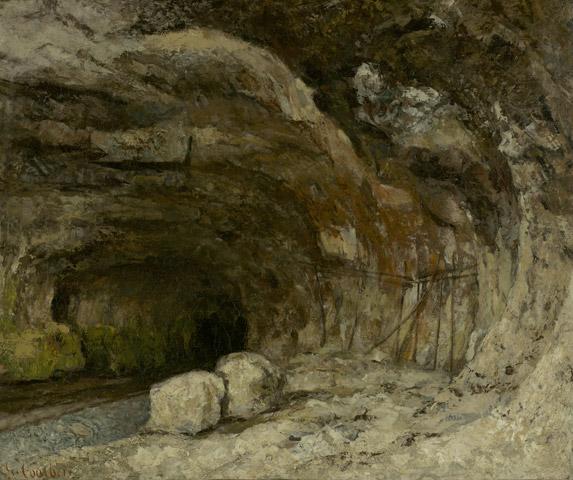Gustave Courbet Gallery
Oil on canvas
19 3/4 x 23 5/8 in.
Signed: G. Courbet (lower left)
2004.47
The J. Paul Getty Museum has recently acquired Grotto of Sarrazine near Nans-sous-Sainte-Anne, an important painting by French Realist Gustave Courbet. In his radical approach to technique and composition, Courbet rejected the refined style of French academic painting and its rigid parameters for subject matter. Grotto of Sarrazine near Nans-sous-Sainte-Anne demonstrates Courbet's challenge to tradition through the artist's bold application of paint and dynamic composition.
During the 1860s, Courbet often painted caves and similar sites near his home in a mountainous region near Switzerland. The Sarrazine grotto's craggy surfaces and its geological evolution are suggested in his technique. Working in stages with brushes and palette knives, Courbet built up and scraped away paint, working drying pigment into the wet surface. The painting's composition is radically modern, because the artist's perspective appears both near and far. Up close, the cave's natural colors—greens, ochers, browns, whites—and details, such as manmade scaffolding, are singled out. Yet the artist stepped back enough to capture the cave's curving, all-encompassing structure.
Grotto of Sarrazine near Nans-sous-Sainte-Anne complements the Getty's strong holdings of French nineteenth-century paintings, drawings, and photographs. It joins other Courbet works: a painting, Bouquet of Flowers in a Vase, and two drawings, Head of a Sleeping Bacchante and Standing Female Nude.
Courbet's landscapes bridge the work of Jean-Baptiste-Camille Corot and Claude Monet. As one of a number of paintings Courbet made of caves, Grotto of Sarrazine anticipates the serial nature of Monet's late paintings, such as Wheatstacks, Snow Effect, Morning and The Portal of Rouen Cathedral in Morning Light. Similarities can also be drawn in their close-up views and thick application of paint. In its treatment of rural, non-idealized subject matter, Grotto of Sarrazine is also comparable to Jean-François Millet's Man with a Hoe, another Realist picture painted at about the same time. But where Millet's canvas emphasizes the human figure and can be interpreted as a form of social protest, Courbet's focus is on the tangible reality of the empty landscape.

viewer |
|
|
| Porteuses de Fagots |
Grotto of Sarrazine |
| Standing Female Nude |
| Bohemienne et ses Enfants |
| Rock at Bayard, Dinart |
| Reclining Woman |
| Woman with a Parrot |
Biography
Bulletin Board
Renowned Art
(home)
all artists, with thumbnails: by birth year | alphabetically
all artists: by birth year | alphabetically
artists born in the 13th 14th 15th 16th 17th 18th 19th 20th century